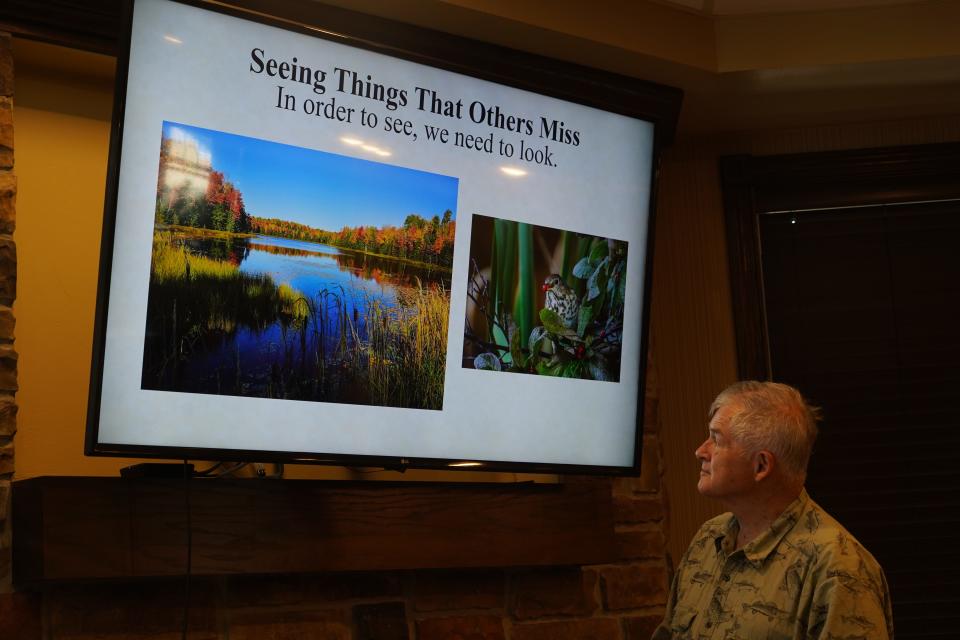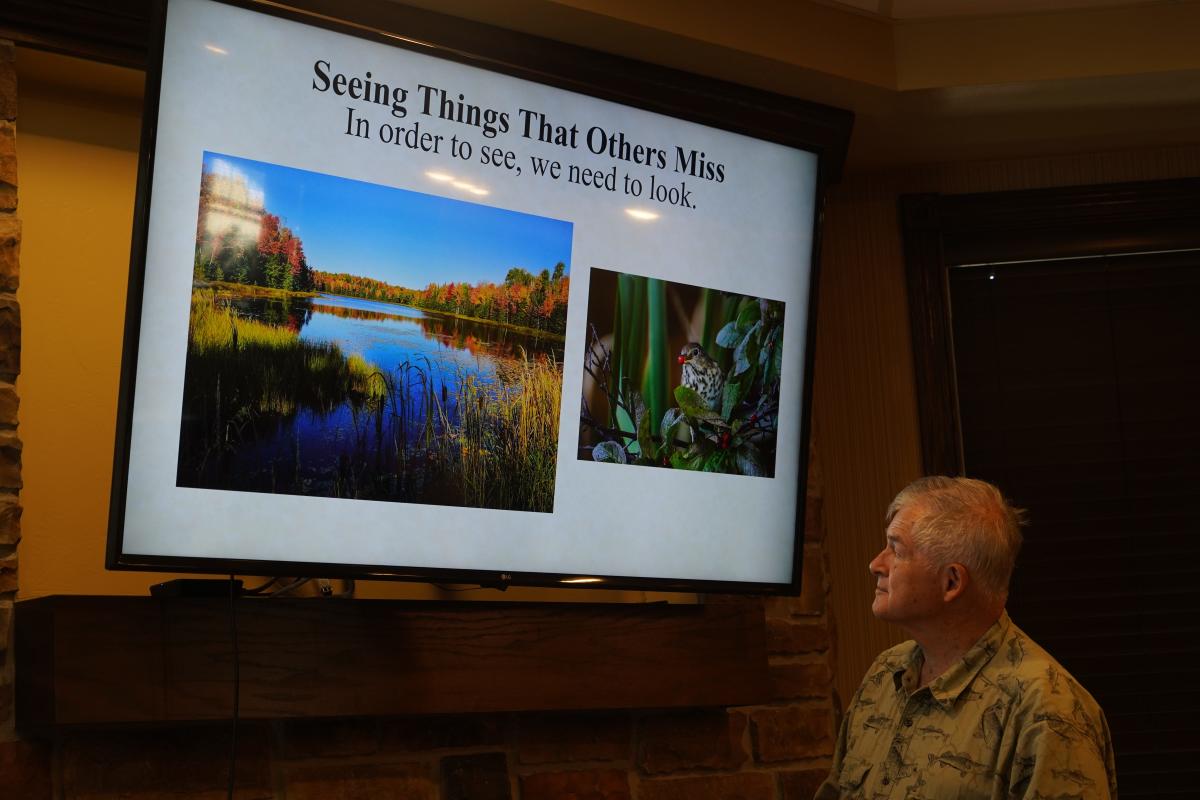[ad_1]

APPLETON – The pub at Primrose Retirement Community was bustling at 2 p.m. July 11.
“Oh, just a second, I’ll get you a chair,” said Christine Dicus, the facility’s life enrichment director, as two more residents showed up.
Every table was full but it wasn’t for Happy Hour, bingo or a party. In fact no drinks or food were being served.
The crowd of 32 assembled for a slide show of nature photography.
The program was given by Bob Haase of Eldorado and was titled “The Beauty of Nature Through the Eyes of a Photographer.”
His first slides included scenes of brilliant fall foliage reflecting on the surface of a North Woods lake, a thrush plucking a red berry from a shrub and red fox kits playing in a field.
“Not only does photography bring me closer to nature, but it gives me a positive attitude,” said Haase, 79. “How could I be in a bad mood watching a fox kit playing like this?”
The photo showed a young fox holding the tail of a littermate in its mouth.
Over 40 minutes, Haase showed 164 images culled from the tens of thousands he has captured in his career.
The goal: inspire the audience with impactful images, help stimulate conversation and evoke memories.
“I think pictures have a unique ability to help us remember a time or place or feeling,” Haase said.
Haase decided to bundle his photographic talent in a presentation at Primrose after two friends, Jerry and Gloria Norris, moved to the facility in 2019.
Jerry was in declining health and Haase knew his friend, with whom he had attended college, would appreciate seeing some of the fruits of his recent camera work.
The idea expanded from a personal viewing in 2022 to an event in Primrose’s life enrichment program. Primrose has residents in independent living, assisted living and memory care units at its Appleton campus.
“(Haase) is so talented,” said Dicus, the event director. “He brings the outside in. It turned out to be a big hit.”
The life enrichment program offers six activities on weekdays and four on weekends, Dicus said. The goal is to provide enrichment in social, emotional, physical, spiritual, purposeful and intellectual realms.
After Haase gave the presentation last year, Dicus said the first question from the audience was: “When are you coming back?”
So Haase and Dicus scheduled a follow-up for July 11.
Such a program is more than just viewing beautiful images.
Several studies have shown looking at nature photos can stimulate the memories and senses of older adults, including people with dementia, for example.
“Not just scenery: Viewing nature pictures improves executive attention in older adults,” a 2014 study by Katherine Gamble and colleagues at Georgetown University showed the value of exposure to nature images.
The work found that viewing nature (and not urban) images significantly improved executive attention in older adults as measured by the Attention Network Test.
Among a growing number of interventions, nature exposure offers a quick, inexpensive, and enjoyable means to provide a boost in executive attention, the researchers concluded.
Laurence Aegerter, a visual artist based in Amsterdam, uses nature images as part of a project she calls “Photographic Treatment.” The effort hopes to improve the quality of life of elderly people with dementia by staging “photo interventions.”
Her work was featured in a 2018 article published on CNN.com.
In one example, Aegerter describes meeting a dementia patient in the later stages of the illness at a care facility in Switzerland. She visited the man to note his reactions to photographs she had brought along.
She asked him to remark on the images but he was relatively unresponsive, “fluttering in out of awareness, like a lamp flickering on and off,” she said. For 10 minutes, the patient hardly said anything.
Then Aegerter said she showed him a photograph of a cat and a kitten; the image provoked a marked change.
“He was able to speak for five minutes in a row,” Aegerter said in the report. “That image triggered something very deep in him, a very deep memory that made him feel so strong. In those minutes, it was like he had no disease at all.”
Haase said he isn’t surprised by such studies. And though he hasn’t researched it, he believes images are an effective way to reach people.
He’s seen it work in various ways over more than six decades.
Haase grew up in central Wisconsin and started his relationship with shutter speeds, f-stops and lighting while a student at Montello High School. He worked for the student newspaper and yearbook.
He went on to get degrees at UW-Platteville and UW-Stout and eventually joined the faculty at Moraine Park Technical College in Fond du Lac where for 27 years he taught graphics, production and photography.
Haase retired in 2001. The year was no coincidence. His father had died at the age of 57 so Haase decided he would stop working at that age and try to enjoy as much life as he could, knowing nothing is guaranteed.
Haase now devotes most of his time to volunteering and nature photography. He is a delegate to the Wisconsin Conservation Congress, gives fly-tying lessons through Trout Unlimited and is on the board of directors for the Wisconsin Outdoor Communicators Association.
He makes local photography outings to public parks and preserves, including Heckrodt Wetland Reserve in Menasha, as well as private properties.
He and his wife Mary also spend time at their cabin set on a scenic lake in northern Wisconsin.
A few times a year he also goes farther afield on photo trips to places such as Sax-Zim Bog, about 30 miles northwest of Duluth, Minn., or Montana or Wyoming.
A digital camera is always at his side. Haase estimates he captures about 5,000 images a month.
He has about 2 TB of stored images.
“What good do they do sitting on my hard drive if nobody can see them?” Haase said.
Haase put that sentiment in action at Primrose. Over 40 minutes he showed birds, mammals, scenics. All were of the high quality you’d see in a nature magazine.
A photo of hooded merganser ducklings drew “oohs” from the crowd. So did an image of a white doe with normally-colored fawns.
“I like animals at a distance and I’ve never seen them as close as this,” said Primrose resident Pat Maronek, 87. “And those colors are unheard of.”
For Maronek, the slide show brought back memories of one of her favorite places, McGill Pond in Stevens Point.
Her fellow resident Marcie Tautges, 84, also enjoyed it.
“The lake scenes reminded me of Mayflower Lake near Birnamwood,” Tautges said. “It looked like home.”
The group stayed for 10 minutes of questions and answers: What kind of camera do you have? Are their things left to see and photograph?
Haase said nature photography helps him start each day with a positive attitude. And yes, there are many things he still wants to do, including photograph grizzly and polar bears.
He thanked the group for inviting him again. The room slowly emptied about 3 p.m. But dozens of conversations continued as residents walked or wheeled out.
Haase would like other nature photographers to consider doing the same types of programs at assisted living facilities, nursing homes and schools. He is planning to offer the program to other facilities this year.
“If I can reach one person, brighten one person’s day, it’s worth it,” Haase said.
More: Wisconsin ruffed grouse drumming is down, signaling a low in the population cycle
Smith: Lake Michigan chinook salmon fishing as hot as the weather
This article originally appeared on Milwaukee Journal Sentinel: Nature photographer shows images to stimulate memories, senses
[ad_2]
